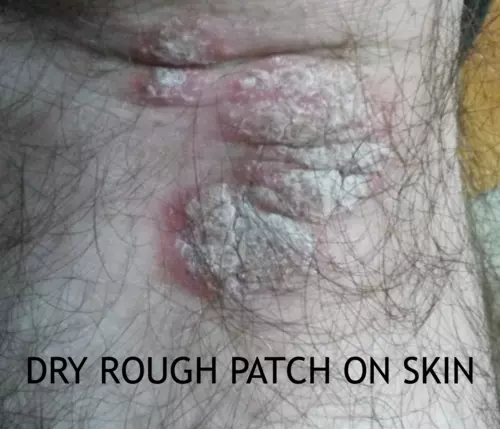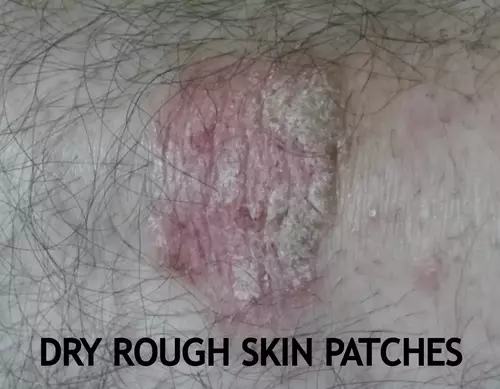Dry rough patch on skin are a common dermatological symptom that can indicate either a temporary failure of the barrier functions of the epidermis or a skin disease. It all depends on the size of the spots, the clarity of their boundaries, and the length of time they have been present on the skin.

Causes of Dry Rough Patch on Skin
The causes of dryness can be divided into two large groups:
- nonspecific – allergic reactions to household chemicals, laundry soap, cosmetic products, dehydration due to cold and wind;
- Specific – then the spots are a manifestation of dermatological diseases.
Sometimes a person may himself notice that his skin appears dry spots after a certain event, for example, after washing laundry by hand. Then the cause is obvious and easy to eliminate. But if the dry patches on the skin do not go away, itchy, flaky, you should see a doctor.
Types of Dry Rough Patch on Skin
Dry patches with rough scales
Pink raised dry patches on the body and head may indicate psoriasis. In this dermatological pathology, a person develops raised plaques – psoriatic papules – on the skin. They protrude above the surface of the skin, cause intense itching and flaking, and tend to spread and coalesce.
Psoriasis is a chronic autoimmune disease in which rashes are most often localized on the elbows, head, knees, and groin. Dry pink spots covered with white scales are foci of chronic inflammation. Under the influence of internal autoimmune processes, epidermal cells divide several times faster than necessary. As a result, small scales from the dying skin cells are constantly detached.
Atopic dermatitis and its differences from psoriasis
Atopic dermatitis can also result in dry patches on the body. And as with psoriasis, they cause itching. Because of the increased sensitivity of the skin to environmental factors, the mechanisms of its self-regulation are disrupted, including the barrier function suffers. That is, the trigger for atopic dermatitis is an allergy, but the propensity for such a skin reaction is genetic.
Most often atopic dermatitis occurs in children. The disease has a chronic course, with exacerbations alternating with periods of remission. Here are the typical signs of atopic dermatitis:
- dry skin;
- peeling and reddening of the eyelids;
- dry flesh-colored plaques on the torso and extensor areas of the body;
- cracks.
It is difficult for a person without medical training to distinguish between psoriasis and atopic dermatitis, but a doctor can easily make a differential diagnosis. There are several differences that may speak in favor of one or the other pathology. Atopic dermatitis more often affects children, psoriasis can debut in adulthood. Psoriatic plaques are elevated above the skin, and scales can be seen. Dry patches in atopic dermatitis are flat. It is also important to consider the typical localization.
Dry eczema

Sometimes white, dry, flaky patches on the skin of the feet can indicate dry eczema. This condition first causes dry and tight skin, followed by peeling and unbearable itching, and cracks may occur. In addition to the feet, the hands, the area between the fingers, and even the face are often affected.
The causes of dry eczema may be bacterial and fungal infections, allergens, synthetic clothing, poor hygiene and other factors.
Conclusion
As you can see, the appearance of dry rough patches on the skin can be caused by a variety of reasons. A major role played by the peculiarities of the immune system and the propensity for allergic reactions. But in any case, when dry spots appear, it is important to see a dermatologist and determine the cause of this skin condition.
About the Author
Reyus Mammadli is the author of this health blog since 2008. With a background in medical and biotechnical devices, he has over 15 years of experience working with medical literature and expert guidelines from WHO, CDC, Mayo Clinic, and others. His goal is to present clear, accurate health information for everyday readers — not as a substitute for medical advice.






